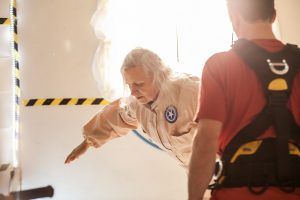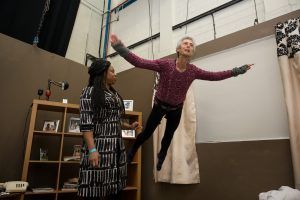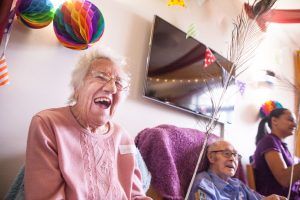Four years ago, David Slater at Entelechy Arts asked me what might circus look like and be like if it were created with older people. At the time, I was exploring ideas for a new show about ageing: as a circus artist approaching my 40s, I was beginning to consider what getting older would mean for my professional and personal relationships. I was increasingly aware that I knew very few role models over 50 still working in the industry.

From the first session it was clear that doing circus skills workshops with a group of older people was going to generate interesting questions. I had spent weeks planning the session to make sure I could offer participants, who were in their 60s, 70s, 80s and 90s, the appropriate level of physical challenge. What I had not fully anticipated was the way the activity would challenge notions of ageing and identity within the group and further afield.
Each session became a catalyst for discussions, I had to re-plan my time to allow space for talking and sharing. Conversations ranged from discussions about how we perceived our bodies to the power people had over their lives, over the decisions made about them and the choices and risks we were allowed to take.

The workshops evolved into Falling & Flying, a project exploring the relationship between circus and falling in older people. Upswing was funded by the Gulbenkian Foundation in partnership with Entelechy Arts to hold a series of labs. We bought in film maker Edwin Mingard, poet Simon Mole and technologist Malcolm Buchanan-Dick to consider, alongside a group of older people, experiences of ageing and our physical environment.
One of the outputs of the labs was a short film that drew a parallel between the lived experience of older people and those living and astronauts. Following one aerial session the conversation drifted to how people ‘choreographed’ their movements at home, One participant, Madeline, spoke about the way she arranged furniture and objects, the corner of a dresser, a pile of books on her sideboard or windowsill, so that they became supports for moving around. Her empowering-yet-fragile environmental adaptations allowed her to live independently. The next day Edwin brought in a video of an astronaut giving a tour around a space station.
It made us consider the way that, in some contexts, the adaptation of an environment to enable survival, the narrative can be heroic and adventurous. When we think of space it evokes images of the future and the unknown and at the moment it is something only a handful of individuals on earth have actually experienced. As more of us become older, environments built for older people will become more common, and so to consider them now is to consider the future also.
By framing older people within the environment of the space station our thought was to translate their experience into a narrative that has a positive, futuristic glow. Comparison between the two physical environments pushes us to re-consider the resilience of older people and the way that environments can enable independence.

Since then, we have gone on to bring circus practice to other contexts: last year in partnership with Magic Me and Anchor, Upswing developed a 10-week programme, which brought the circus to Silk Court Care Home in Bethnal Green. Our artists ran sessions in juggling, acrobatics, magic, music, clowning, crafts and even aerial dance.
We planned sessions that incorporated some performance from artists as a moment of inspiration but then shifted into active participation. We wanted to give staff and residents new, playful ways to interact together as opposed to simply delivering entertainment. Where possible, staff were encouraged to work with residents one-to-one to build up their confidence in continuing the activity beyond our residency. Circus is a great leveller; everyone who participated started as a beginner. There was a joyful unpredictability in where latent talent would emerge and it offered everyone taking part new perspectives on each other’s abilities.
Around the activities, residents were often asked to link the activity to storytelling adding meaning and value. It vividly brought the group closer together, and created a greater intimacy between our incoming artists and participants. Initially, our team were tempted to keep activities happy and upbeat but, over the course of the project, we learnt that it was a good thing to create space for deeper emotional reactions and experiences.
The project grew from initial uncertainty about the appropriateness of the content into an eagerly anticipated highlight for residents and staff alike, allowing them to play, learn, share, create and experiment. It has opened up a new space for circus to exist and has allowed us as artists to understand how, without instrumentalising our artform, it can be so much more than simply spectacle.